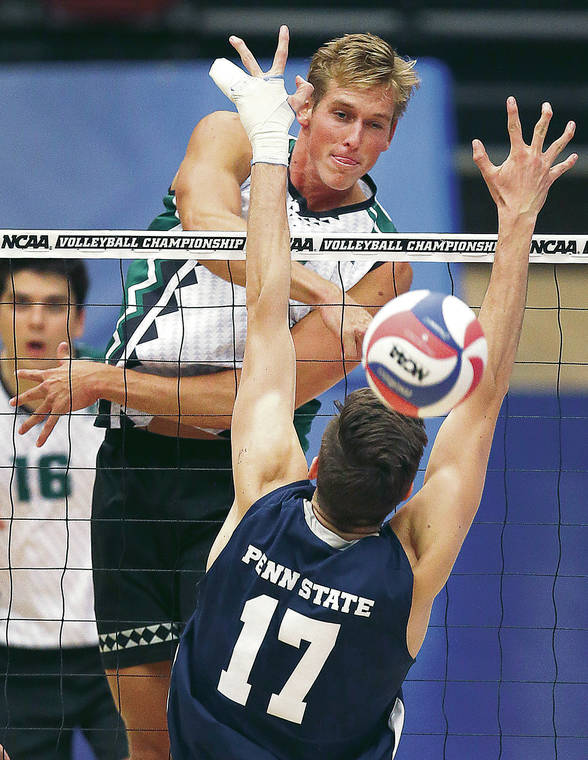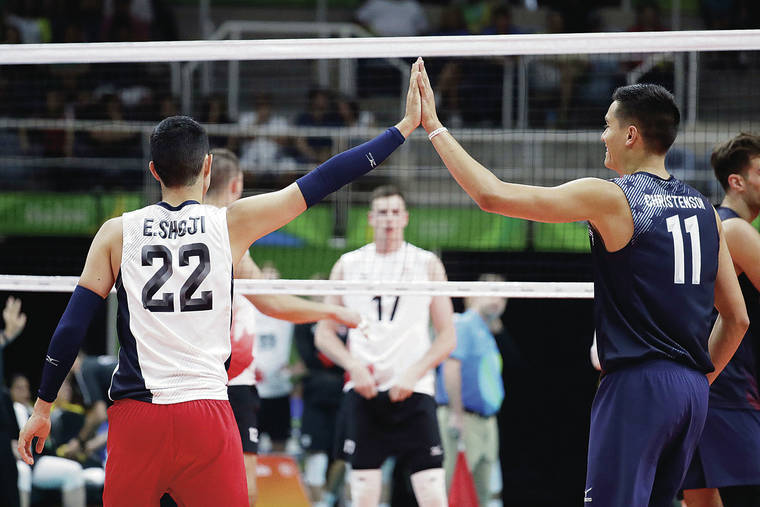When the parade of nations comes through the tunnel and onto the track at Tokyo’s Olympic Stadium exactly a year from Wednesday, Hawaii is expected to be well represented among the U.S. group walking prior to the flame being lit.
It is likely — as happened in 2016 — that the biggest Hawaii contingent will be on the men’s indoor volleyball team. Three of the 12 on the squad who won the bronze medal in Rio de Janeiro were from the islands: setters Micah Christenson (Kamehameha) and Kawika Shoji (‘Iolani) and libero Erik Shoji (Punahou).
Although the Americans — ranked No. 2 in the world — have yet to qualify, should they advance to make the 8-mile trek from the stadium in the Heritage Zone to Ariake Arena in the Tokyo Bay Zone, that trio from Hawaii could be repeat U.S. Olympians.
Christenson and the Shoji brothers were part of the U.S.’s silver-medal performance in the recent Volleyball Nations League. The seven-week competition also saw three others with Hawaii ties get playing time: former University of Hawaii All-Americans Taylor Averill, a middle, and libero Tui Tuileta, and Tuileta’s Punahou teammate Micah Ma’a, the latter used at both setter and outside hitter.
U.S. national team coach John Speraw has only 12 roster spots and, while Speraw — also the UCLA men’s coach — said he didn’t want to “jinx it because we have to qualify,” he gave some insights into the player selection process when contacted by the Honolulu Star-Advertiser.
“We plan on taking only one libero,” he said. “And Erik (Shoji) is the best in the world. There may be others who dig a few more balls, but he is the best passer, knows the game so well, is just exceptional.
“And he and Micah (Christenson) have started all the major matches for us this quad (four years between Olympics). Kawika is still our second guy (at setter), is an exceptionally talented athlete.”
Although the U.S. finished second in the VNL, Christenson was named the best setter and Erik Shoji the best libero in the 16-team competition.
The first of two Olympic qualifiers is the 24-team FIVB Intercontinental on Aug. 9-11, where the top six teams earn their tickets to Tokyo. Should the U.S. not qualify, the Americans’ last chance is January in the North American Zone Qualifier, where only the winner goes to Japan.
Speraw has a gym full of choices as the team tries to qualify for its 11th Olympics since the sport was introduced at the 1964 Tokyo Games. On that inaugural roster from Hawaii were Pete Velasco (captain) and the late Jake Highland.
Speraw has played with and coached a number of players from Hawaii, both on the national team and at UCLA. The latest of the Bruins was Ma’a, a two-time first-team All-American who played both setter and hitter, something he was pressed into doing due to injuries in VNL play.
“We all marveled at Micah,” Speraw said. “You go back in history and I haven’t heard of anyone who could set in one match then hit over .350 as an outside at this level. That he’s doing it as a young player is incredible.
“Micah is right there for consideration, as is Josh (former Long Beach State setter Tuaniga). Taylor is battling, has had great training camps, but (middle) is also our deepest position.”
Speraw, also the U.S. Olympic coach in 2016, said he has enjoyed having Hawaii players in the training gym and on the competition court.
“Every (player from Hawaii) that I’ve ever coached is of high-quality character, and when you have high character, you are a good teammate,” he said. “There is such cultural influence in Hawaii for the sport, the style of play that encourages high volleyball IQ.
“In Hawaii, you grow up around the game and you absorb it at an early age. They see the game and all its nuances. It’s special.”
Note
Hawaii’s lone representative on the women’s side likely will be former Washington All-America libero Tama Miyashiro, who is currently serving as a U.S. assistant for Karch Kiraly.






